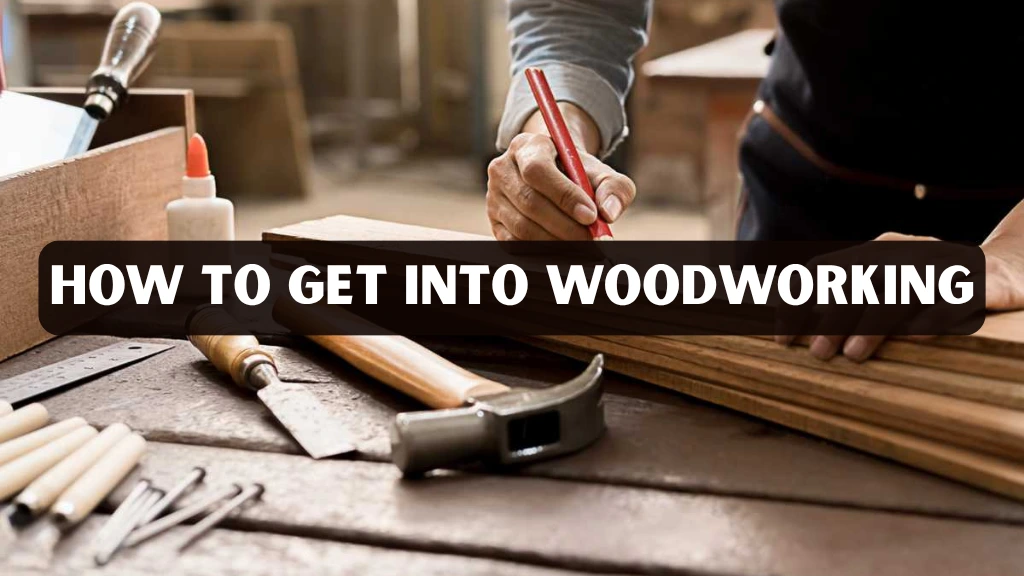Woodworking is one of the most rewarding and creative hobbies you can pursue. For beginners, the prospect of working with raw wood can be both exciting and overwhelming. From shaping wooden objects on a lathe to crafting furniture, woodworking allows you to transform a simple piece of wood into functional art. In this comprehensive guide, we’ll explore everything you need to know to get started with woodworking, including essential tools, beginner-friendly projects, safety tips, and resources to enhance your skills. Whether you aim to pursue woodworking as a hobby or explore it professionally, this guide will help you take the first step confidently.
Why You Should Learn How to Get into Woodworking
Woodworking offers more than just a hobby, it’s a skill that fosters creativity, patience, and problem-solving abilities. When you begin this craft, you open the door to endless possibilities. Transforming raw wood into furniture, decorative items, or functional tools gives you a chance to express creativity while building a valuable skill set. Beginners often find joy in watching a simple piece of wood evolve into something meaningful through their efforts.
This process also sharpens important abilities like hand-eye coordination, precision, and focus. Each cut, sanding stroke, and joint made contributes to better craftsmanship. At the same time, woodworking provides stress relief, offering a hands-on activity that allows you to disconnect from screens and daily pressures. The satisfaction of completing a project whether big or small brings a sense of accomplishment and fulfillment.
Another rewarding aspect is joining the woodworking community. Whether through online forums, social media groups, or local workshops, connecting with other enthusiasts provides inspiration and learning opportunities. Sharing techniques, asking questions, and seeing others’ work fosters growth and motivation. Most importantly, understanding how to get into woodworking the right way ensures you build skills efficiently, avoid common mistakes, and enjoy the craft to its fullest.
Essential Woodworking Tools for Beginners
Before starting any woodworking project, it’s important to have the right tools. While you don’t need a full workshop at first, having the essentials makes the journey smoother and more enjoyable. For beginners, basic hand tools are critical for building foundational skills. A sturdy hammer is indispensable for assembly, screwdrivers secure joints, chisels help with carving and shaping, and a reliable hand saw allows precise cuts. Measuring tools such as tape measures, squares, and calipers ensure accuracy and consistency in your work.
Power tools can enhance efficiency and expand the scope of your projects. An electric drill speeds up assembly, a circular saw handles larger cuts, and a jigsaw is perfect for curves and intricate designs. An orbital sander creates smooth finishes with little effort, while a woodturning lathe opens the door to shaping bowls, pens, and cylindrical objects with precision. These tools allow you to progress from simple builds to more advanced woodworking tasks.
Safety equipment is equally essential. Protective glasses guard against debris, dust masks or respirators keep you safe from sawdust, and hearing protection reduces noise exposure. Gloves also add extra hand protection during cutting, sanding, or carving. For beginners, investing in a few quality tools instead of buying everything at once is a smart approach. It saves money, reduces confusion, and keeps the focus on learning. Understanding which tools are essential is a major part of learning how to get into woodworking successfully.
Setting Up Your Woodworking Space
Creating a dedicated workspace is crucial for both efficiency and safety. Even a small area can serve as a productive workshop if it is properly organized. Adequate lighting should be a top priority, as bright, evenly distributed light minimizes mistakes and allows you to see fine details in your work. Ventilation is equally important, preventing dust buildup and ensuring clean air circulation when using power tools. A stable workbench also serves as the cornerstone of any woodworking setup, giving you a reliable surface for cutting, sanding, and assembling.
Organization is another essential aspect of setting up your shop. Keeping tools, materials, and safety gear in designated spots helps prevent accidents while making your workflow smoother. Access to electrical outlets is necessary for powering drills, saws, sanders, and other equipment. A clean, well-maintained environment not only boosts productivity but also motivates you to practice regularly. For beginners learning how to get into woodworking, creating an efficient workspace is a foundational step that sets the stage for long-term success.
Understanding Wood Types
Understanding the characteristics of different types of wood is an essential part of woodworking. Each type of wood has its own properties, which directly influence how it is cut, shaped, and finished. Beginners who take the time to learn these distinctions often find that their projects turn out more polished and enjoyable to complete.
Softwoods such as pine, cedar, and fir are among the best choices for newcomers. They are lightweight, easy to shape, and forgiving when mistakes are made, which makes them excellent for practicing fundamental techniques and completing small, manageable projects. Hardwoods like oak, maple, and walnut, on the other hand, are denser and more durable. While they require more skill and precision, they are ideal for long-lasting pieces such as furniture and decorative items.
For those seeking unique textures and colors, exotic woods such as mahogany, teak, and rosewood provide striking results. However, these woods are often more expensive and can be challenging for beginners due to their hardness and grain patterns. Choosing the right wood not only impacts the look of your project but also determines how easily your tools perform. By understanding differences in grain, hardness, and workability, beginners can avoid frustration and achieve better results
Beginner-Friendly Woodworking Projects
Starting with simple projects is one of the best ways to practice essential woodworking skills while building confidence. Small and manageable items are especially ideal for beginners because they provide quick results and a rewarding sense of accomplishment. These projects help you focus on the basics without feeling overwhelmed by complexity.
Wooden keychains are excellent starter pieces since they allow you to practice precision work on a lathe while creating something both functional and decorative. Once you feel comfortable, you can move on to slightly more advanced projects such as pen holders and desk organizers, which teach important skills like measurement, assembly, and finishing. Small bowls or plates also provide an opportunity to explore woodturning techniques in greater depth.
Practical projects like coasters, cutting boards, shelves, and boxes further expand your abilities by teaching sanding, shaping, and structural assembly. These items not only enhance your skill set but also result in functional pieces you can use at home or in your workshop. Working on beginner-friendly projects is the perfect way to learning without feeling discouraged. For a hands-on example, you can explore our step-by-step wooden keychain tutorial, which walks you through your very first project from start to finish.
Woodturning Basics Lathe Techniques
Woodturning is a unique branch of woodworking that focuses on shaping wood into rounded or cylindrical forms. To achieve smooth, professional results, beginners must understand how lathe speed and proper tool handling affect the outcome. The diameter of the wood plays a crucial role in speed adjustments. Larger pieces require slower rotation to ensure stability and reduce the risk of accidents, while smaller pieces can be turned faster for a polished finish. Correctly positioning the tool rest is equally important, as it helps maintain steady control throughout the process.
Mastering different cutting methods, such as roughing, shaping, and finishing cuts, allows projects to take form gradually and with precision. Safety remains essential at every step; using protective glasses, dust masks, and securing the workpiece prevents unnecessary hazards. Many beginners find woodturning both challenging and rewarding, making it one of the most exciting skills to explore when discovering how to get into woodworking .
Learning Resources for Woodworking
Continuous learning plays a central role in the growth of every woodworker. Online tutorials and video guides are excellent resources, offering step-by-step instructions on projects that range from beginner-friendly keychains to more advanced woodturning techniques. Books and manuals also provide valuable depth, giving detailed explanations of woodworking methods that are useful for both beginners and experienced hobbyists.
Beyond self-study, community engagement is another powerful way to improve. Forums, social media groups, and local workshops allow you to share your work, ask questions, and learn directly from others’ experiences. Attending classes or joining makerspaces offers hands-on practice with personalized guidance from skilled instructors. Together, these resources make learning efficient, accessible, and confidence-building. For more detailed insights, the Wikipedia Woodworking Guide serves as a reliable external reference covering techniques and history.
Case Study
Take the example of Alex Johnson, a 32-year-old office worker who decided to try woodworking during the pandemic. With no prior experience, he started small in his garage using only a basic workbench, a hammer, chisels, and a hand saw. His first project was a simple wooden keychain, which taught him measurement, cutting, and sanding. Motivated by this success, he moved on to a desk organizer, gradually adding tools like an electric drill to handle more complex tasks.
As Alex gained confidence, he invested in a woodturning lathe and began making bowls and pens. By combining online tutorials with feedback from woodworking forums, he improved quickly and built a collection of over 20 projects in his first year. Encouraged by family and friends, he launched a small Etsy shop, turning his new hobby into a side business. His journey proves that with dedication and the right resources, anyone can successfully learn, even with minimal tools and space at the beginning.
Conclusion
Getting into woodworking is a rewarding and creative experience that allows you to develop skills, patience, and imagination. When you begin this craft, focusing on the right tools, learning about different wood types, and setting up a functional workspace lays the foundation for success. Simple projects help you gain confidence and improve techniques, while gradually introducing more advanced tasks ensures steady progress.
Incorporating woodturning techniques adds another layer of excitement, giving you the ability to craft both functional and decorative pieces with precision. With guidance from online resources, community forums, and tutorials, anyone can learn how to get into woodworking effectively. The combination of practice, creativity, and shared knowledge makes this journey both educational and deeply satisfying.
FAQs
What is the easiest woodworking project for beginners?
Simple projects such as wooden keychains, small bowls, coasters, or pen holders are ideal. These allow you to practice essential skills without being overwhelmed.
Do I need a lathe to start woodworking?
No, many projects can be completed with basic hand tools. A lathe is specifically useful for woodturning projects, but beginners can start without one.
How much does it cost to start woodworking?
The initial cost depends on your chosen projects and tools. A beginner can start with a budget of $100–$300 for essential hand tools and materials. As you grow, investing in power tools and a lathe may increase costs.
Can woodworking be done in a small space?
Yes, woodworking is possible in small garages, basements, or corners of a room. Adequate lighting, ventilation, and organization make even limited spaces workable.




